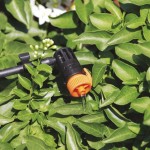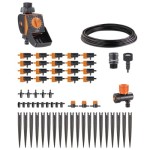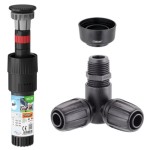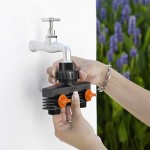Houseplant Care
Choosing the right houseplant plant for your home can be fun and rewarding. Not all houseplants are created equal. Some plants prefer bright light, while others prefer low light. Some plants prefer dry soil, while others prefer moist soil. Do some research to find plants that will thrive in your home's environment. Our Plantsmith range of professional and natural formulations provides the essentials for your houseplants need to thrive. The products are made with natural ingredients and are vegan and cruelty-free.
Some tips for looking after Houseplants include:
- Water your plants regularly. The amount of water your plants need will vary depending on the type of plant, the size of the pot, and the climate. A good rule of thumb is to water your plants when the top inch of soil is dry.
- Fertilize your plants regularly. Fertilizing your plants will help them to grow and thrive. Use a liquid fertilizer that is specifically formulated for houseplants. Repot your plants as they grow. As your plants grow, they will need to be repotted into a larger pot. This will give them the room they need to grow and develop.
- Watch for pests and diseases. Houseplants can be susceptible to pests and diseases. If you see any signs of pests or diseases, take action immediately to treat them.
- Enjoy your plants! Houseplants can bring a touch of nature to your home and improve your overall well-being. Take some time to enjoy your plants and watch them grow.
Here are some additional tips for caring for your houseplants.
- Clean your plants' leaves regularly. This will help to remove dust and debris, which can block the leaves' ability to photosynthesize.
- Rotate your plants regularly. This will help to ensure that all sides of the plant receive equal amounts of light.
- Prune your plants regularly. This will help to keep them healthy and encourage new growth.
- Place your plants in a well-lit spot. Most houseplants prefer bright, indirect sunlight. However, some plants, such as succulents and cacti, prefer full sun.
- Avoid placing your plants in cold or drafty areas. This can shock the plants and cause them to drop leaves or die.
- Be patient! It takes time for houseplants to grow and thrive. Don't get discouraged if your plants don't look perfect right away. With a little care and attention, they will eventually reach their full potential.
Orchid care tips include
- Place your orchid in a spot with indirect sunlight. Orchids love light, but direct sunlight can scorch their leaves. An east- or west-facing windowsill is ideal.
- Water your orchid regularly, but not too much. The potting mix should be moist, but not soggy. Allow the potting mix to dry out completely between waterings. Be careful not to overwater your orchid. Too much water can lead to root rot, which can kill your plant.
- Use a special orchid fertilizer. Orchids need a specific fertilizer that is high in nitrogen, phosphorus, and potassium. You can find this fertilizer at most garden centers. Fertilize your orchid once a month during the spring and summer. Use a balanced fertilizer that is diluted to half strength, the Plantsmith Orchid Cracker or Gift Set is perfect for this.
- Keep your orchid's humidity levels between 50-70%. Orchids are native to tropical regions and love high humidity. If the humidity in your home is too low, you can use a humidifier to increase the humidity. Mist your orchid's leaves regularly to increase the humidity around the plant. You can also place your orchid on a pebble tray filled with water.
- Don't place your orchid near a heater or air conditioner. Heaters and air conditioners can lower the humidity in your home, which can be harmful to your orchid.
- Repot your orchid every 2-3 years. Orchids grow quickly and need a larger pot every 2-3 years. Be sure to choose a pot that is a few centimetres larger than the old pot.
- Remove dead or damaged leaves. Dead or damaged leaves can become a source of infection for your orchid. Remove them regularly to keep your orchid healthy.
- Be patient! Orchids can take some time to adjust to their new environment. Don't be discouraged if your orchid doesn't bloom right away. With proper care, it will eventually bloom and thrive for many years to come.
Some of the most common Houseplants in the UK include:
- Variegated Monstera (Monstera Deliciosa Albo Variegata) is a tropical plant that is native to Central and South America. It is also known as the Swiss Cheese Plant or the Split-Leaf Philodendron. This plant is known for its large, heart-shaped leaves that have holes in them. The holes are formed as the plant matures. Monstera Deliciosa is a relatively easy plant to care for. It prefers bright, indirect light and moist soil. It is also important to keep the humidity levels high around the plant. You can do this by grouping it with other plants, placing a pebble tray under the pot, or using a humidifier. Monstera Deliciosa is a fast-growing plant. It can reach heights of up to 6 feet indoors. If you want to keep your plant smaller, you can pinch back the new growth.
- Spider plant (Chlorophytum comosum). This plant is known for its air-purifying qualities and its ability to thrive in low-light conditions. It is also relatively easy to care for, making it a good choice for beginners.
- ZZ plant (Zamioculcas zamiifolia). This plant is also known for its air-purifying qualities and its ability to tolerate neglect. It is a good choice for people who travel frequently or who simply don't have a lot of time to care for their plants.
- Snake plant (Sansevieria trifasciata). This plant is another low-maintenance plant that is tolerant of low light. It is also known for its ability to remove toxins from the air.
- Peace lily (Spathiphyllum). This plant is known for its white flowers, which bloom in the spring and summer. It is a good choice for people who want a plant with some visual interest.
- Fiddle-leaf fig (Ficus lyrata). This plant is known for its large, glossy leaves. It is a good choice for people who have a lot of space and who want a statement plant.
- Pothos (Epipremnum aureum). This plant is known for its trailing vines and its variegated leaves. It is a good choice for people who want a plant that is easy to care for and that can be grown in hanging baskets or on shelves.
- African violet (Saintpaulia ionantha). This plant is known for its colorful flowers, which bloom year-round. It is a good choice for people who want a plant with some visual interest and who are willing to provide it with bright, indirect light.
- Boston fern (Nephrolepis exaltata bostoniensis). This plant is known for its delicate fronds and its ability to thrive in humid conditions. It is a good choice for people who have a humid home or who are willing to mist their plants regularly.
- Some of the popular Philodendron house plants include. Philodendron bipinnatifidum, also known as the lacy tree philodendron, is a large, vining plant with deeply lobed leaves. It prefers bright, indirect light and moist soil. Philodendron cordatum, also known as the heart-leaf philodendron, is a smaller, bushier plant with heart-shaped leaves. It prefers bright, indirect light and moist soil. Philodendron erubescens, also known as the blushing philodendron, is a striking plant with red-veined leaves. It prefers bright, indirect light and moist soil. Philodendron hastatum, also known as the fiddle-leaf philodendron, is a large, vining plant with large, glossy leaves. It prefers bright, indirect light and moist soil. Philodendron micans, also known as the micans philodendron, is a small, trailing plant with velvety leaves. It prefers bright, indirect light and moist soil.
- Tradescantia popular forms include: Tradescantia zebrina, also known as the wandering jew or inch plant, is a trailing plant with variegated leaves in shades of green, silver, and purple. It prefers bright, indirect light and moist soil. Tradescantia pallida, also known as the purple heart, is a trailing plant with heart-shaped leaves in shades of purple and green. It prefers bright, indirect light and moist soil. Tradescantia fluminensis, also known as the wandering dude or Brazilian wandering jew, is a trailing plant with green leaves that are often edged in pink or white. It prefers bright, indirect light and moist soil. Tradescantia albiflora, also known as the white-inch plant, is a trailing plant with white leaves that are often edged in green. It prefers bright, indirect light and moist soil. Tradescantia tricolor, also known as the rainbow plant, is a trailing plant with leaves in shades of green, yellow, and pink. It prefers bright, indirect light and moist soil.
Some of the most common varieties of orchid in the UK include:
- Phalaenopsis (moth orchid) is the most popular type of orchid in the UK. It is easy to care for and blooms for many months.
- Dendrobium is another popular type of orchid in the UK. It is a bit more difficult to care for than Phalaenopsis, but it can produce stunning blooms.
- Oncidium is a type of orchid that is known for its colorful flowers. It is a bit more difficult to care for than Phalaenopsis or Dendrobium, but it is well worth the effort.
- Miltonia is a type of orchid that is known for its large, fragrant flowers. It is a bit more difficult to care for than Phalaenopsis or Dendrobium, but it is a beautiful and rewarding plant to grow.
- Cymbidium is a type of orchid that is known for its long-lasting flowers. It is a bit more difficult to care for than Phalaenopsis or Dendrobium, but it is a beautiful and hardy plant.
There are no products to list in this category.














